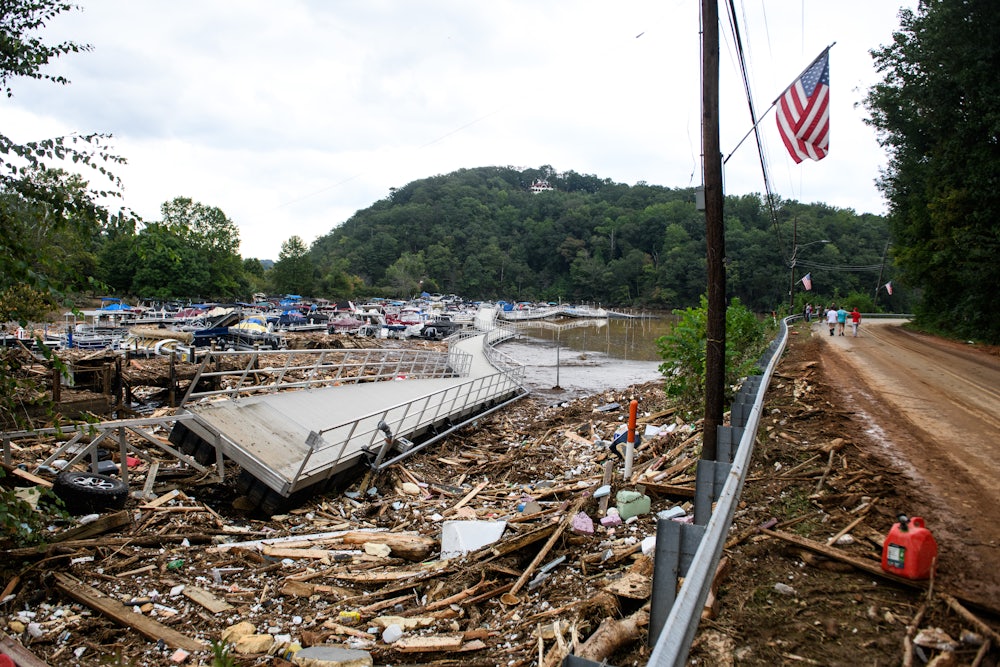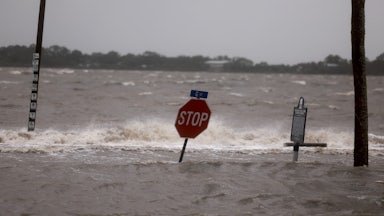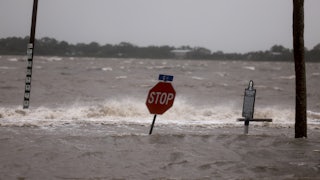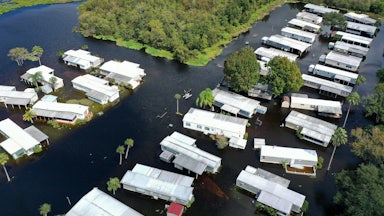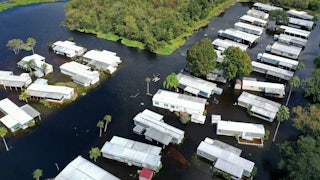Days before Southeastern states were ravaged by Hurricane Helene—with catastrophic flooding affecting inland areas previously thought to be relatively protected from the increasingly frequent storms intensified by climate change—Congress left Washington without approving any additional funding for disaster relief.
Despite the knowledge that Helene would make landfall on Thursday, lawmakers embarked on a six-week recess for the preelection campaign sprint last Wednesday, after passing a bill keeping the government funded temporarily through December. Left out of the measure: billions of dollars in supplemental disaster funding. Although the temporary measure extended funding for the Federal Emergency Management Agency through December 20, the agency’s disaster relief fund is facing a $3 billion deficit by February. Rather than receiving the bulk of its money through the regular appropriations process, the relief fund is primarily funded through supplemental appropriations bills in response to major disasters—measures that come with their own complications.
“Sometimes Congress is very quick to respond to a disaster, sometimes they’re not, and you don’t know what else is going on in the political cycle that will affect the decision-making,” said Andy Winkler, leader of the Bipartisan Policy Center’s Task Force on Disaster Response Reform. “Any kind of delay or uncertainty in what the resources are that are available can create delays in the recovery.”
FEMA has been “pushed to its limits” since 2017, which saw massive damage wrought by Hurricanes Maria, Harvey, and Irma, Winkler said. It continues to run on fumes: In August, FEMA announced it was shifting into “immediate needs funding” mode, meaning that it will prioritize emergency lifesaving work over longer-term recovery projects. Meanwhile, several states are waiting on recovery assistance for disasters that happened earlier this year—or even last year, such as the devastating fires in Maui and the collapse of a bridge in Baltimore. Other federal disaster recovery programs that fall outside of FEMA’s purview involving long-term recovery, such as the Department of Housing and Urban Development’s long-term block grant program known as CDBG-DR, have also not received new funding this year.
Winkler noted that the stress on FEMA may also be attributable to shifting perceptions of what the agency’s role should be whenever the need for post-disaster relief and recovery arises, highlighting the recent increase in the number of federal disaster declarations, which kick off the emergency funding process. “The mission is expanding, and at the same time you’re seeing really difficult workforce shortages at FEMA. And so we’re asking them to do more, we expect more, but at the same time, we’re not necessarily giving them the tools and the resources to be able to do that well,” said Winkler.
Despite the pending shortfall in the disaster relief fund, federal officials have insisted that they are able to adequately respond to the damage wrought by Helene. In an interview with CBS News’s Face the Nation on Sunday, FEMA administrator Deanne Criswell said, “We absolutely have enough resources from across the federal family.”
“FEMA is one part of the team, and we have the ability to bring in all of our team members from many other federal agencies to support this response,” Criswell said. However, while the stopgap measure temporarily funding the government allowed for FEMA to tap into $20 billion that was part of last year’s spending levels, the extent of the crisis caused by Helene may result in the agency burning through that money more quickly.
“Americans, in their greatest time of need when an area gets hit by disaster, expect government to work. FEMA is one of those agencies that people rely on when disaster strikes in their community,” said Representative Jared Moskowitz, a Democrat from Florida and a leader in disaster response efforts in the House. “Congress is the disaster. And getting anything done there now, in the 118th Congress—anything that makes sense in the 118th Congress seems impossible.”
Since 2005, when several massive hurricanes—including Hurricane Katrina—rampaged through the South, supplemental appropriations funding for disaster relief has spiked. Between 1992 and 2004, disaster relief fund spending averaged to around $5 billion annually; between 2005 and 2021, that spending rose to an average of $12.5 billion annually, excluding pandemic expenses, according to the Congressional Budget Office. Meanwhile, the number of billion-dollar natural disasters has also climbed over the past two decades; according to the National Oceanic and Atmospheric Administration, 2023 saw a record 28 billion-dollar natural disasters. The annual number of thunderstorms costing $1 billion or more has also increased significantly since 2000.
Rather than approving funding on a piecemeal basis through supplemental legislation, Congress should fund FEMA more fully from the beginning, argued Moskowitz. “You fix that problem by giving them the correct amount of money that they need at the beginning of the budget cycle. If you give them $20 billion for their budget, and then they need a $12 billion supplemental during the year, you should have just given them $32 billion from the beginning,” he said.
Part of the issue with approving supplemental disaster relief stems from larger institutional problems on Capitol Hill, as the appropriations process writ large has increasingly fallen victim to toxic partisan politics. Congress is generally so dysfunctional that only a few must-pass items are guaranteed approval in a given year: namely, the massive legislation authorizing hundreds of billions of dollars in defense funding, and legislation to keep the government funded. While the latter has become more difficult than the former—often resulting in a slapdash appropriations process, monster omnibus bills, and the occasional shutdown—Congress is usually able to keep the lights on in the federal government.
Given that political gridlock means fewer bills are actually able to pass through Congress, lawmakers with an agenda to push have little recourse for their individual crusades—meaning that must-pass legislation can be forced to become a vehicle for partisan fights. The urgency of supplemental disaster relief funding typically ensures its passage, although not without some political acrimony.
“If everyone thinks that it’s got to pass because it is really important to get that money out the door, then we also get into the question of, are there other political conflicts that are going to get wrapped up in trying to get that done?” said Molly Reynolds, senior fellow of governance studies at the Brookings Institute and an expert on congressional process.
Moreover, certain segments of the Republican Party—particularly in the House—are often concerned with ensuring that spending on disaster relief is offset by cutting costs elsewhere. Nearly 200 House Republicans famously voted against emergency relief after Superstorm Sandy ravaged much of the Northeast in 2012.
The politicization of climate change also makes it difficult for members of Congress to agree that there is a problem in intensifying natural disasters, which in turn can make it harder to pass preventative measures. Congress has generally struggled to approve such measures for other disasters, such as pandemic preparedness. But when proposing the idea that preventive funding is necessary because climate change is intensifying natural disasters, that “takes the issue squarely into the contentious political debate over whether climate change is real,” said Reynolds. (For the record, it is.)
“The idea of Congress acting in advance to prepare for these sorts of natural disasters is difficult simply because we’re talking about the future, and then it’s made more difficult because we’re talking about a problem that the two parties don’t agree is a problem,” said Reynolds. Despite the overwhelming evidence that the earth is warming at an unprecedented rate due to human activity—and despite the majority of Americans who acknowledge that global warming is happening—climate change remains a contentious political subject in Congress.
Aside from the political dynamics of climate change, immediate action on disaster relief is unlikely. When asked whether he would have to call Congress back into session to address disaster relief, President Joe Biden said on Monday that possibility was “something I may have to request, but no decision’s been made yet.”
Although some lawmakers have called on Congress to return to Washington in October to address the issue of disaster relief funding, it is more probable that this issue will be addressed during the lame-duck session between Election Day and the end of the year—along with priorities such as the National Defense Authorization Act, the farm bill, and appropriations. Nonetheless, some members of Congress have identified disaster relief as the first ticket on the lame-duck to-do list.
“When we return in November, passing disaster aid has to be the top priority of the United States Congress,” Democratic Senator Brian Schatz, who represents Hawaii, said in a speech on the Senate floor last week. “This is an American priority, and we cannot close up shop for this Congress leaving all these Americans behind.”
This piece has been updated.
